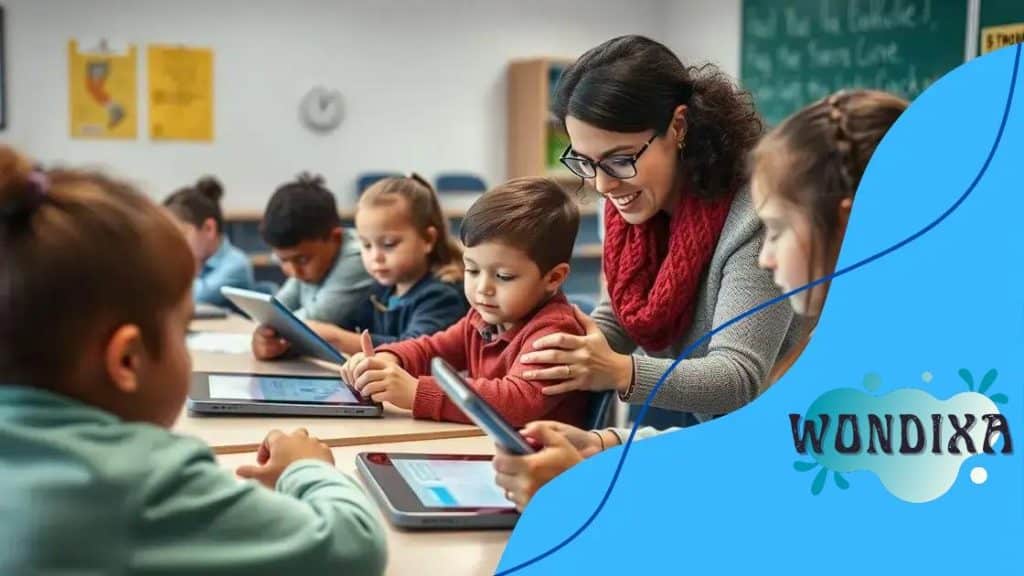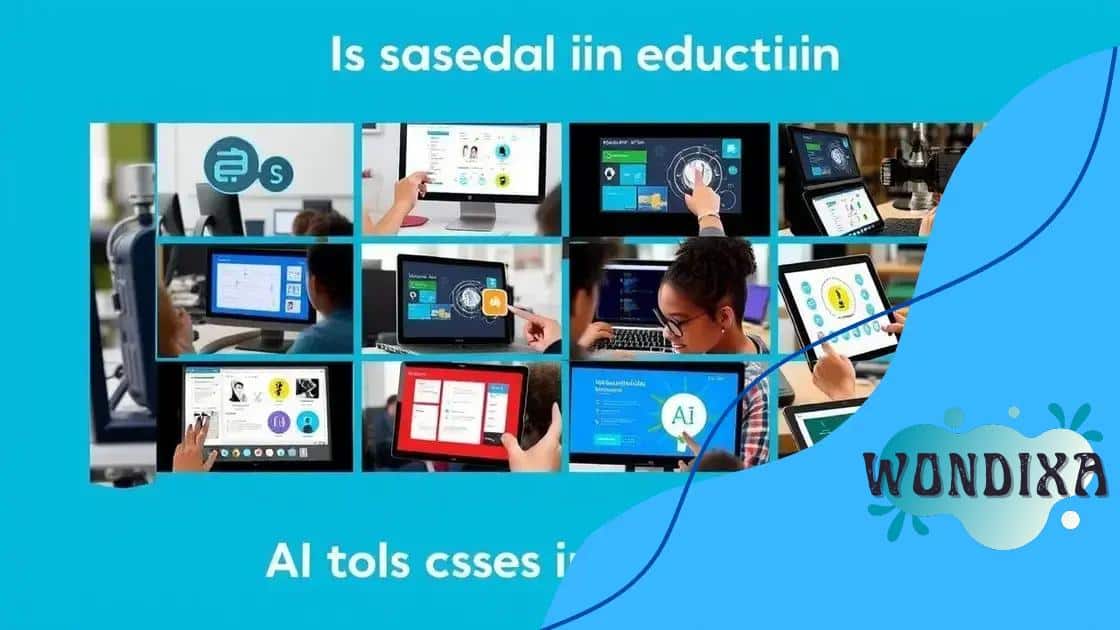AI-assisted learning for students with disabilities

AI-assisted learning for students with disabilities enhances education by providing personalized resources, improving engagement through interactive tools, and facilitating better communication for diverse learning needs.
AI-assisted learning for students with disabilities is transforming education by making resources more accessible and tailored to individual needs. Have you considered how these technologies could change the learning experiences for students? Let’s dive into this fascinating topic.
Understanding AI-assisted learning
Understanding AI-assisted learning is essential for making education more inclusive. It enhances the learning experience for all students, especially those with disabilities. By leveraging this technology, educators can create unique pathways for learning that meet diverse needs.
What is AI-assisted learning?
AI-assisted learning refers to the integration of artificial intelligence in educational settings to provide personalized support to students. This involves using algorithms that adapt to individual learning styles. By analyzing data, these systems can offer tailored resources that help students grasp complex concepts more easily.
Benefits of AI for students
- Enhanced personalization in learning activities
- Immediate feedback on assignments and tests
- Accessible resources that cater to individual needs
- Improved engagement through interactive tools
These benefits highlight how AI-assisted learning can transform traditional education into a more supportive environment. Furthermore, the use of AI tools enables teachers to focus on each student’s strengths and challenges.
As schools adopt these technologies, it’s crucial to understand their implications. By embracing AI, educators can look forward to significant advancements in teaching methods and student engagement. Every student deserves access to quality education, and AI-assisted learning is paving the way for that.
Key benefits for students with disabilities
Understanding the key benefits for students with disabilities is vital for creating inclusive educational environments. These advantages can empower students and enhance their learning experiences.
Enhanced Learning Opportunities
One of the most significant benefits is the creation of enhanced learning opportunities. AI tools provide a range of educational resources that cater to different learning styles. This means students who might struggle in traditional settings can access tailored support that meets their specific needs.
Improved Engagement
AI solutions can improve student engagement by making learning more interactive. For instance, gamified learning platforms utilize AI to adapt challenges based on student performance. As a result, students are more motivated to participate and can enjoy learning.
- Interactive lessons that captivate attention
- Real-time feedback from AI systems
- Opportunities for peer collaboration through smart tools
These tools not only assist in understanding content but also foster a sense of community among students. Furthermore, students receive immediate feedback, helping them identify areas for improvement.
Another key benefit is the availability of assistive technologies, which support students in various ways. These technologies can help with communication, understanding written material, and social interactions, making learning more accessible overall. As educators learn to implement AI-assisted learning efficiently, they can truly make a difference in their students’ lives.
Examples of successful AI tools

Exploring examples of successful AI tools can offer valuable insights into how these technologies enhance learning for students with disabilities. Various platforms have made significant strides in providing accessible learning experiences, making them essential for educators.
Speech Recognition Software
One prominent tool is speech recognition software, which allows students to convert spoken words into text. This is especially beneficial for those who have difficulties with writing. The technology improves communication and helps students express their thoughts clearly.
Interactive Learning Platforms
Another example includes interactive learning platforms that adapt lessons to the individual pace and style of each student. These platforms use AI algorithms to analyze student performance, offering personalized exercises to enhance understanding. Some popular tools include:
- DreamBox Learning: A math program that adjusts to student progress in real time.
- Khan Academy: Offers personalized learning paths with immediate feedback.
- Ghotit: A spelling and grammar checker for students with dyslexia.
These tools ensure that students remain engaged and can tackle lessons without feeling overwhelmed. Furthermore, using such platforms encourages a sense of independence, allowing students to learn at their own pace.
AI-assisted learning goes beyond just these examples. As technology continues to evolve, more tools are emerging, helping students overcome barriers and create a more inclusive learning environment. Overall, the success of these AI tools illustrates the tremendous potential of technology in education.
How educators can implement AI solutions
Learning how educators can implement AI solutions is crucial for enhancing the learning environment. Incorporating AI into the classroom can greatly benefit students, especially those with disabilities.
Training and Professional Development
One of the first steps is for educators to undergo training. By understanding how AI tools work, teachers can effectively integrate them into their lessons. Professional development workshops can offer hands-on experience.
Selecting the Right Tools
Next, educators need to select appropriate AI tools that suit their students’ needs. This involves evaluating different platforms focused on accessibility and engagement. Some tools worth considering include:
- Natural Language Processing tools to help with reading comprehension.
- Adaptive learning software that adjusts content based on student performance.
- AI-driven assessment tools for tracking progress.
These selections should align with the curriculum and enhance learning opportunities. Once the right options are identified, teachers can start small by integrating one or two tools into their existing lessons.
Collaboration among educators is also essential. Sharing experiences and strategies can help in modifying approaches as needed. Teachers can create a community of practice that supports each other and enhances the overall implementation process.
By regularly assessing the impact of these tools, educators can fine-tune their approaches, ensuring that every student benefits. AI solutions not only assist in personalizing education but also make learning more engaging and effective.
Future trends in AI and education
The future trends in AI and education promise to reshape how we teach and learn. As technology evolves, new opportunities are arising to enhance student engagement and learning outcomes.
Personalized Learning Experiences
One significant trend is the shift toward personalized learning experiences. AI allows for curriculum adjustments based on each student’s strengths and weaknesses. This tailored approach ensures that students receive the support they need.
Virtual Reality and Augmented Reality
Additionally, the integration of virtual reality (VR) and augmented reality (AR) into classrooms is on the rise. These technologies provide immersive learning experiences, enabling students to explore complex subjects through interactive simulations. Benefits include:
- Enhanced understanding of difficult concepts.
- Opportunities for real-world applications.
- Increased motivation among students.
As educators embrace these methods, they can open up new avenues for exploration and engagement. Furthermore, AI’s ability to analyze data allows for better tracking of student progress and intervention when needed.
Another important trend involves the use of AI for administrative tasks. Automation of grading and scheduling frees up time for teachers to focus on instruction. This efficiency can lead to improved educational outcomes and a better classroom experience.
As we look ahead, we can anticipate more partnerships between educational institutions and tech companies. This collaboration will likely propel the development of innovative tools aimed at supporting diverse learning needs. The future of education will be more equipped to cater to every student’s journey.
FAQ – Frequently Asked Questions about AI-assisted Learning for Students with Disabilities
How can AI improve learning for students with disabilities?
AI provides personalized learning experiences by adapting content to meet individual needs, helping students grasp complex concepts more effectively.
What are some examples of AI tools used in education?
Examples include speech recognition software, adaptive learning platforms like DreamBox Learning, and interactive tools that enhance engagement and understanding.
How can educators effectively implement AI in the classroom?
Educators can start by undergoing training, selecting suitable AI tools, and collaborating with colleagues to share effective strategies for integrating technology.
What does the future hold for AI in education?
The future likely includes more personalized learning experiences, enhanced use of virtual and augmented reality, and improved administrative efficiencies through automation.





